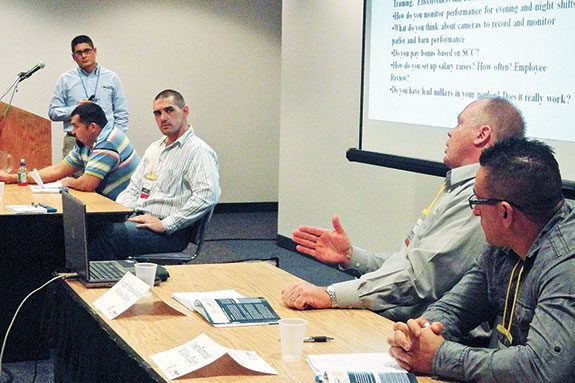When it comes to working with Hispanic dairy employees, never make an assumption. That was the key message and theme behind the panel discussion, “Managing Hispanic labor … is it about the culture or is it about the rules?,” held during the Midwest Dairy Expo November 27-28 in St. Cloud, Minnesota. More than 75 producers and dairy industry members attended the one-hour session moderated by Jorge Delgado, on-farm support manager for Alltech.
Panelists Dwight Hasselquist and Jose Ramirez, both of Willow Dairy, and Garret Luthens and Chico Da Silva, both of Skyview Dairy , shared examples of how they have not only improved communication with Hispanic employees in their operations, but also increased productivity and efficiency on their dairies.
“The first question we must ask is who is responsible for employee management and why,” Delgado said as he opened the dialogue among the panel discussion. “Regardless of the size of your farm or business, training plays an important role in its success.”
“We need to explain what we do and why we do it the way we do it,” said Da Silva, herd manager at Skyview Dairy near Hutchinson, Minnesota.
The panel discussed employee training and skill development. One example offered was to have a training course where owners teach employees how to operate machinery.
“Remember that most of these guys haven’t operated a tractor in their lives, don’t know the right way to start a tractor, how fast they should go or how to read the controls,” Delgado said.
According to Delgado, another area that often needs to be addressed is to make sure the herdsman has the support of the owner, and the staff needs to know that he or she has the full support of the owner and speaks on the owner’s behalf.
“Let the employees know it is in their best interest to hire good people when bringing new people to the farm,” added Hasselquist, owner of Willow Dairy in Salix, Iowa. “I choose to promote within the current labor force and will promote people based upon their skills, not their age or time on the job. This can create problems, but with good communication, the employees understand why I have chosen that person for advancement and they can then get past it.”
The panel offered key criteria to consider when hiring new employees on any dairy operation:
• Are they motivated?
• Do they take care of themselves? If they don‘t, what do you think they will do with your operation?
• Do they show up on time for the interview and with the proper documents already in hand?
• Do they pay attention during the hiring process and behave respectfully?
• Do they really understand what you said about their role? Are they asking you questions about the job in return?
• Do they have a good or bad attitude?
“Turnover is tricky so we always have to be looking for good people, even if we really don’t need anyone,” said Luthens, Skyview Dairy owner.
On the topic of how to motivate employees, each dairy had their own suggestions. Spelling out clear goals and expectations, monitoring performance, giving feedback, and setting up salary raises based on performance and time were some of the answers from the panel on how they encourage employee productivity and growth in their operation.
“Give a reward or raise when it is earned and don’t wait to have a formal review, because they don’t always get done in a timely manner and someone should not have to wait when they are doing a good job,” Luthens said.
The session concluded with tips for improving communication with employees. A common mistake among dairy producers that manage Hispanic labor is assuming their workforce is fluent in English.
“They may understand some words or speak several words in English, but that does not mean they can interpret a meeting, follow technical instructions or train and welcome new workers to your operation,” Delgado said. “Unless you have a proven, fluent bilingual person on your team to be a bridge between you and your Hispanic workers, you may want to consider an on-farm program to assist with communication and training.”
The panel also added that dairy owners can eliminate any frustration by listening and paying attention to their employees’ attitudes.
“I ask if the employees need anything when going to town. This shows I care and want them to have the tools they need to do their jobs,” Hasselquist said.
Delgado agreed, “As owners, the very least you need to know is how to say good morning, good afternoon, good night, please and thank you in the language of your workers. Even if you don’t speak the language, you need to read and use body language to get your message across.”
“Bottom line, let people know they are appreciated,” Da Silva said. PD
PHOTOS
TOP RIGHT: The panel offered key criteria to consider when hiring new employees on any dairy operation. Photo courtesy of Jorge Delgado.
—Submitted by Alltech








